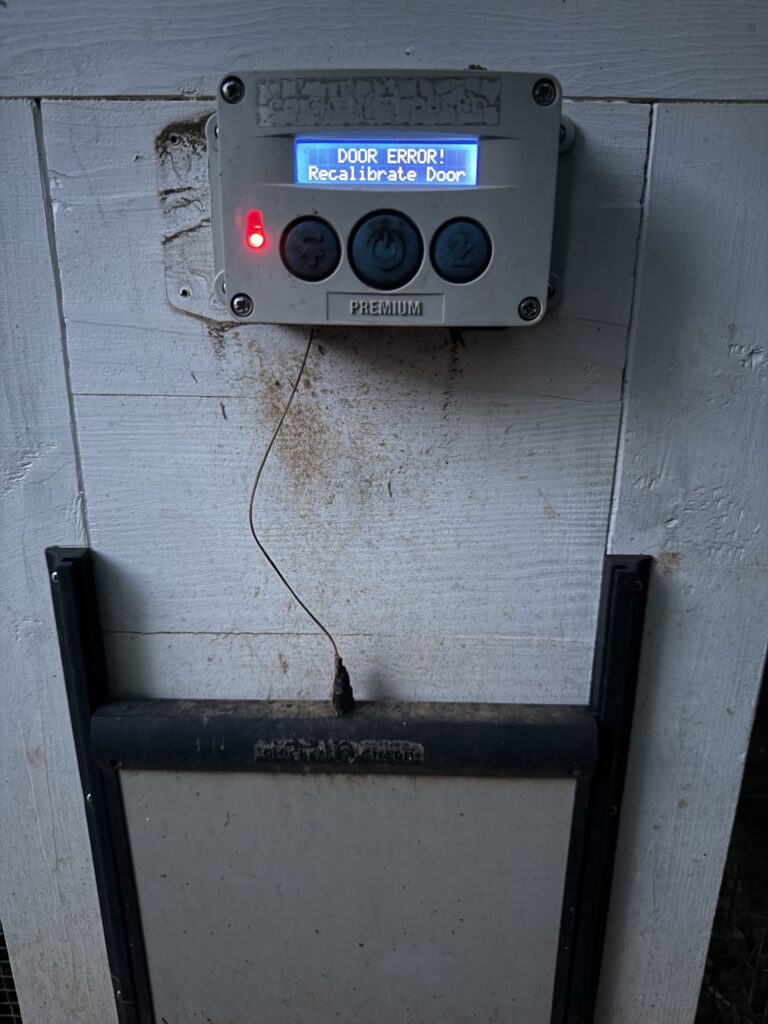Recently, I realized I had forgotten something in the backyard. So I went outside, and since I was already there, I decided to check on the chickens. Shockingly, I discovered that our automatic chicken door was wide open because the batteries had died. My heart sank. After losing two geese to predators not that long ago, I raced back to the house to grab a set of fresh batteries.
That was a reminder that while automatic chicken doors are incredibly convenient, they can fail with disastrous consequences.
We’ve been using automatic chicken doors from Chickenguard and Chickcozy for several years to increase our flexibility and reduce the time we spend on chores. But even the best door can die (often when you least expect it), so we don’t recommend trusting them blindly.
In this article, I’ll share our experience with the automatic chicken doors we’ve installed in our stationary and mobile coops (where we raise egg layers, broilers and turkeys). I’ll also talk about the relative pros and cons of the two brands mentioned above.
But before we get to that deep-dive, here a side-by-side comparison of their key features:
| Feature | Chickenguard (Vertical) | Chickcozy (Horizontal) |
|---|---|---|
| Power options: | Battery, AC plug, solar + batteries | Solar + built-in battery, AC plug |
| Warranty: | 3 years | 2 years |
| Opening mechanism: | Track or pulley | Track |
| Clearance needed: | Overhead | Side clearance |
| Price: | $160 (battery powered) or $170 (solar powered) | $170 |
| Best for: | Stationary, deep coops | Mobile tractors, low roof |
What to Consider When Buying an Auto Chicken Door

1. Door Opening Direction
Chickenguard doors open vertically via a pulley or rail system, which requires sufficient clearance above the door to allow for full opening. In contrast, the Chickcozy doors open horizontally, which requires enough clearance on each side of the door.


We started with doors from Chickenguard for our two stationary coops, but realized that this design wouldn’t work for the Justin Rhodes-inspired mobile chicken tractor, which didn’t have space above the door opening. That’s why we decided to go with a battery-powered door from Chickcozy that required no extra space above the door.
2. Power Source and Backup
How to power the door is the second decision you need to make. We’re huge fans of solar power when combined with batteries (to keep the door operational in case the sun doesn’t shine for extended periods), and recommend going with a solar-powered option unless your coop is located in an area that doesn’t receive direct sunlight.
Unfortunately, neither Chickenguard nor Chickcozy offered solar-powered options at the time we built our coops (they do now), so we opted for battery-powered models.
We also tried USB power on the Chickenguard door, but found outdoor outlets tripped GFCIs too often, so we switched back to batteries.
Our Chickcozy door also arrived with an AC power plug, but since our mobile chicken tractor doesn’t have an outlet nearby, we relied on batteries to keep the door powered.
The good news is that the batteries on those doors usually last for about a year. Set a reminder to replace them every 10 months or so to avoid the same issue I encountered.
Going forward, we’ll opt for solar + battery combinations to make the annual battery changes a thing of the past.
3. Warranty and Customer Support
If you decide on using an automated chicken door, it becomes a critical piece of infrastructure in your poultry operation. After all, it allows your birds to access their run or pasture, and it prevents predators from getting in at night.
With that in mind, you want a door that’s well-built and a reliable way to reach the manufacturer in case something goes wrong and you need a spare part or a replacement door.
I remember that I accidentally broke one of the prongs required to connect the display to the control board of our Chickenguard. I reached out to customer support, and they immediately sent me a new control panel. That makes me feel better in case something breaks down the line and I need a spare part.
Fortunately, both Chickenguard and Chickcozy offer a robust warranty on their doors (three and two years, respectively) to cover you in the event of equipment breakdown.
What I like about Chickenguard is that you have the option to choose between calling and emailing their customer support team.
I don’t have much to say about Chickcozy’s customer support because we never had any issues with their doors (self-inflicted or otherwise). However, it’s worth noting that their customer support team is based in China, which can make it more challenging to reach them by phone. That’s likely why the company recommends sending them an email via a form on their website in the event you need assistance.
4. Plan B (When the Door Stops Working)


Any electronic or mechanical device can break or malfunction. So it’s essential to have a Plan B in place for when that happens.
In our case, the motor of our first Chickenguard door stopped working after many years of service, and I had to find a temporary solution. Fortunately, the chicken coop the door was mounted on also had a regular door we were able to use until I had a chance to replace the malfunctioning Chickenguard with an unused Chickcozy door I had available.
Because I know that any automatic chicken door will malfunction at some point, I strongly recommend checking it every night and ensuring the door has fully closed before you go to bed.
If you don’t, you may wake up one morning and realize that a fox, raccoon or other predator has had your chickens for dinner.
Chickenguard Vertical Chicken Door: Pros and Cons

We started our first flock of egg-laying chickens in the spring of 2021 (you can see them in this video!) using a stationary coop from Carolina Coops. The door we received was an earlier version of what is now called the Pro Door Kit, which utilizes a pulley system and a door with self-locking wings to prevent predators from lifting it open.
When we built our second coop, we also equipped it with a slightly newer version of the Pro Door Kit.
One big thing I like about Chickenguard is their three-year warranty and excellent customer support. As I mentioned above, I accidentally damaged the controller of our door, and they immediately sent me a replacement without asking questions.
The one thing I don’t like about the model of doors we have is the pulley system, because when our chickens exit the coop in the morning, they don’t wait for the door to open fully. Instead, they push the door up, which introduces slack in the string. This, in turn, can cause it to tangle.

I’ve had to open the control box several times over the past few years to untangle the string and roll it up neatly so the door would open and close correctly.
As a result, I’d recommend going with the company’s “All in One” models instead, which rely on tracks rather than a pulley system to open and close the door.
Speaking of recommendations, I’d also opt for the solar-powered version to increase battery life.
The disadvantage of Chickenguard doors is that they require sufficient clearance above the door for the opening and closing mechanism. The lack thereof was the reason we opted for the Chickcozy model on our mobile chicken tractor (also known as the ChickShaw).
From a pricing perspective, you can get a Chickenguard automatic chicken door for as little as $160 for the battery-powered model. For $10 more, you can get the solar-powered version.
Chickcozy Horizontal Chicken Door: Pros and Cons

When we realized that a vertical door wouldn’t work on our mobile chicken tractor (which we had built specifically for raising broilers), we decided to get a horizontal door from Chickcozy. That was in April of 2024, and the door has been working exceptionally well ever since.
What I like about the door is that it’s contained in a single unit without loose wires, and that we can use it with coops that don’t have enough space for a vertical door to work.
It’s worth noting that Chickcozy has since released an updated and improved version of its automatic chicken door. The new version features a solar panel, built-in 3200 mAh rechargeable batteries, and updated door tracks. The latter reduces the likelihood that dirt or debris will negatively impact the door’s operation.
While we’ve never had debris prevent the door from opening or closing, I did notice some of the bedding material lodged inside the door’s tracks (and proactively cleaned it out).
It’s also worth noting that the new solar-powered door is no longer contained within a single shell, allowing you to mount the solar panel in the optimal position for direct sunlight.
As a side note, by mounting the control box higher up on the coop, you won’t have to bend over if you need to make changes to the door’s settings (e.g., to set a closing delay or to switch to manual mode).
As I mentioned, our Chickcozy door has been working flawlessly for the past year or so, and I have never had to contact customer support, which is located in China. However, we’ve been communicating with their marketing team about testing new products, and all communication has been timely and efficient.
From a pricing perspective, the new solar-powered door retails for $170. An optional AC power adapter is available for $10.
Chickenguard vs. Chickcozy: What’s the Better Option?

The choice between Chickenguard and Chickcozy ultimately boils down to three factors:
- What direction do you want the door to open?
- How do you want to power your chicken door?
- Do you prefer a British or Chinese product?
If you have room for a vertical door, appreciate the option of different ways to power the door, and prefer European over Chinese products, Chickenguard is the top choice.
Conversely, if you’re looking for a door that opens horizontally, if you have direct sunlight at your coop and appreciate the convenience of solar, and if don’t mind purchasing a Chinese product, then Chickcozy is a great option.
We’ve been having great success with both and will continue to use both products while also exploring domestically manufactured options.

Michael Kummer is a healthy living enthusiast, the founder of MK Supplements and the host of the Primal Shift podcast. His goal is to help people achieve optimal health by bridging the gap between ancestral living and the demands of modern society. He runs the Kummer Homestead with his wife Kathy and their two children.
